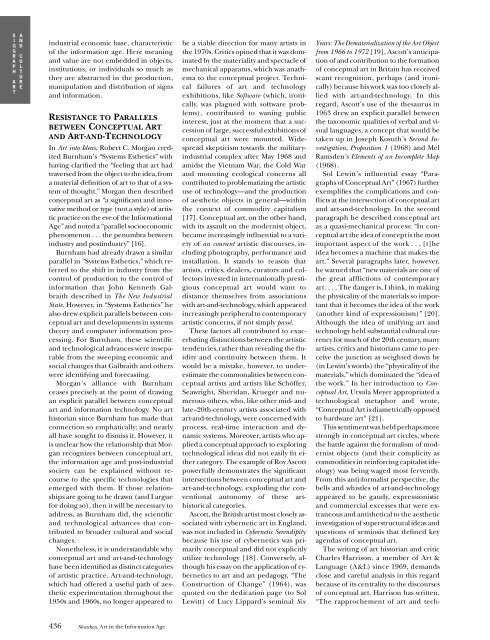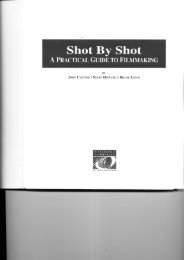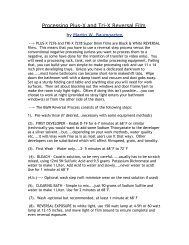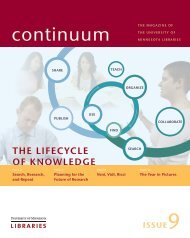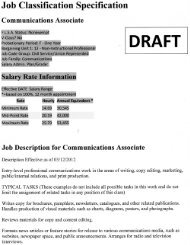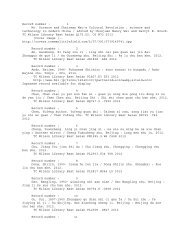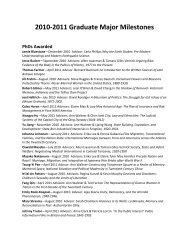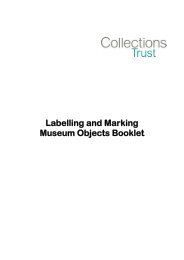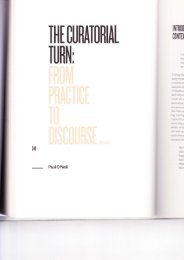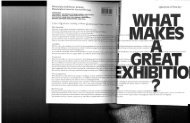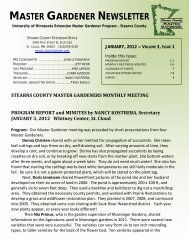Art in the Information Age: Technology and Conceptual Art
Art in the Information Age: Technology and Conceptual Art
Art in the Information Age: Technology and Conceptual Art
You also want an ePaper? Increase the reach of your titles
YUMPU automatically turns print PDFs into web optimized ePapers that Google loves.
S<br />
I<br />
G<br />
G<br />
R<br />
A<br />
P<br />
H<br />
A<br />
R<br />
T<br />
A<br />
N<br />
D<br />
C<br />
U<br />
L<br />
T<br />
U<br />
R<br />
E<br />
<strong>in</strong>dustrial economic base, characteristic<br />
of <strong>the</strong> <strong>in</strong>formation age. Here mean<strong>in</strong>g<br />
<strong>and</strong> value are not embedded <strong>in</strong> objects,<br />
<strong>in</strong>stitutions, or <strong>in</strong>dividuals so much as<br />
<strong>the</strong>y are abstracted <strong>in</strong> <strong>the</strong> production,<br />
manipulation <strong>and</strong> distribution of signs<br />
<strong>and</strong> <strong>in</strong>formation.<br />
RESISTANCE TO PARALLELS<br />
BETWEEN CONCEPTUAL ART<br />
AND ART-AND-TECHNOLOGY<br />
In <strong>Art</strong> <strong>in</strong>to Ideas, Robert C. Morgan credited<br />
Burnham’s “Systems Es<strong>the</strong>tics” with<br />
hav<strong>in</strong>g claried <strong>the</strong> “feel<strong>in</strong>g that art had<br />
traversed from <strong>the</strong> object to <strong>the</strong> idea, from<br />
a material denition of art to that of a system<br />
of thought.” Morgan <strong>the</strong>n described<br />
conceptual art as “a signicant <strong>and</strong> <strong>in</strong>novative<br />
method or type (not a style) of artistic<br />
practice on <strong>the</strong> eve of <strong>the</strong> <strong>Information</strong>al<br />
<strong>Age</strong>” <strong>and</strong> noted a “parallel socioeconomic<br />
phenomenon . . . <strong>the</strong> penumbra between<br />
<strong>in</strong>dustry <strong>and</strong> post<strong>in</strong>dustry” [16].<br />
Burnham had already drawn a similar<br />
parallel <strong>in</strong> “Systems Es<strong>the</strong>tics,” which referred<br />
to <strong>the</strong> shift <strong>in</strong> <strong>in</strong>dustry from <strong>the</strong><br />
control of production to <strong>the</strong> control of<br />
<strong>in</strong>formation that John Kenneth Galbraith<br />
described <strong>in</strong> The New Industrial<br />
State. However, <strong>in</strong> “Systems Es<strong>the</strong>tics” he<br />
also drew explicit parallels between conceptual<br />
art <strong>and</strong> developments <strong>in</strong> systems<br />
<strong>the</strong>ory <strong>and</strong> computer <strong>in</strong>formation process<strong>in</strong>g.<br />
For Burnham, <strong>the</strong>se scientic<br />
<strong>and</strong> technological advances were <strong>in</strong>separable<br />
from <strong>the</strong> sweep<strong>in</strong>g economic <strong>and</strong><br />
social changes that Galbraith <strong>and</strong> o<strong>the</strong>rs<br />
were identify<strong>in</strong>g <strong>and</strong> forecast<strong>in</strong>g.<br />
Morgan’s alliance with Burnham<br />
ceases precisely at <strong>the</strong> po<strong>in</strong>t of draw<strong>in</strong>g<br />
an explicit parallel between conceptual<br />
art <strong>and</strong> <strong>in</strong>formation technology. No art<br />
historian s<strong>in</strong>ce Burnham has made that<br />
connection so emphatically; <strong>and</strong> nearly<br />
all have sought to dismiss it. However, it<br />
is unclear how <strong>the</strong> relationship that Morgan<br />
recognizes between conceptual art,<br />
<strong>the</strong> <strong>in</strong>formation age <strong>and</strong> post-<strong>in</strong>dustrial<br />
society can be expla<strong>in</strong>ed without recourse<br />
to <strong>the</strong> specic technologies that<br />
emerged with <strong>the</strong>m. If those relationships<br />
are go<strong>in</strong>g to be drawn (<strong>and</strong> I argue<br />
for do<strong>in</strong>g so), <strong>the</strong>n it will be necessary to<br />
address, as Burnham did, <strong>the</strong> scientic<br />
<strong>and</strong> technological advances that contributed<br />
to broader cultural <strong>and</strong> social<br />
changes.<br />
None<strong>the</strong>less, it is underst<strong>and</strong>able why<br />
conceptual art <strong>and</strong> art-<strong>and</strong>-technology<br />
have been identied as dist<strong>in</strong>ct categories<br />
of artistic practice. <strong>Art</strong>-<strong>and</strong>-technology,<br />
which had offered a useful path of aes<strong>the</strong>tic<br />
experimentation throughout <strong>the</strong><br />
1950s <strong>and</strong> 1960s, no longer appeared to<br />
436 Shanken, <strong>Art</strong> <strong>in</strong> <strong>the</strong> <strong>Information</strong> <strong>Age</strong><br />
be a viable direction for many artists <strong>in</strong><br />
<strong>the</strong> 1970s. Critics op<strong>in</strong>ed that it was dom<strong>in</strong>ated<br />
by <strong>the</strong> materiality <strong>and</strong> spectacle of<br />
mechanical apparatus, which was ana<strong>the</strong>ma<br />
to <strong>the</strong> conceptual project. Technical<br />
failures of art <strong>and</strong> technology<br />
exhibitions, like Software (which, ironically,<br />
was plagued with software problems),<br />
contributed to wan<strong>in</strong>g public<br />
<strong>in</strong>terest, just at <strong>the</strong> moment that a succession<br />
of large, successful exhibitions of<br />
conceptual art were mounted. Widespread<br />
skepticism towards <strong>the</strong> military<strong>in</strong>dustrial<br />
complex after May 1968 <strong>and</strong><br />
amidst <strong>the</strong> Vietnam War, <strong>the</strong> Cold War<br />
<strong>and</strong> mount<strong>in</strong>g ecological concerns all<br />
contributed to problematiz<strong>in</strong>g <strong>the</strong> artistic<br />
use of technology—<strong>and</strong> <strong>the</strong> production<br />
of aes<strong>the</strong>tic objects <strong>in</strong> general—with<strong>in</strong><br />
<strong>the</strong> context of commodity capitalism<br />
[17]. <strong>Conceptual</strong> art, on <strong>the</strong> o<strong>the</strong>r h<strong>and</strong>,<br />
with its assault on <strong>the</strong> modernist object,<br />
became <strong>in</strong>creas<strong>in</strong>gly <strong>in</strong>uential to a variety<br />
of au courant artistic discourses, <strong>in</strong>clud<strong>in</strong>g<br />
photography, performance <strong>and</strong><br />
<strong>in</strong>stallation. It st<strong>and</strong>s to reason that<br />
artists, critics, dealers, curators <strong>and</strong> collectors<br />
<strong>in</strong>vested <strong>in</strong> <strong>in</strong>ternationally prestigious<br />
conceptual art would want to<br />
distance <strong>the</strong>mselves from associations<br />
with art-<strong>and</strong>-technology, which appeared<br />
<strong>in</strong>creas<strong>in</strong>gly peripheral to contemporary<br />
artistic concerns, if not simply passé.<br />
These factors all contributed to exacerbat<strong>in</strong>g<br />
dist<strong>in</strong>ctions between <strong>the</strong> artistic<br />
tendencies, ra<strong>the</strong>r than reveal<strong>in</strong>g <strong>the</strong> uidity<br />
<strong>and</strong> cont<strong>in</strong>uity between <strong>the</strong>m. It<br />
would be a mistake, however, to underestimate<br />
<strong>the</strong> commonalities between conceptual<br />
artists <strong>and</strong> artists like Schöffer,<br />
Seawright, Sheridan, Krueger <strong>and</strong> numerous<br />
o<strong>the</strong>rs, who, like o<strong>the</strong>r mid- <strong>and</strong><br />
late–20th-century artists associated with<br />
art-<strong>and</strong>-technology, were concerned with<br />
process, real-time <strong>in</strong>teraction <strong>and</strong> dynamic<br />
systems. Moreover, artists who applied<br />
a conceptual approach to explor<strong>in</strong>g<br />
technological ideas did not easily t ei<strong>the</strong>r<br />
category. The example of Roy Ascott<br />
powerfully demonstrates <strong>the</strong> signicant<br />
<strong>in</strong>tersections between conceptual art <strong>and</strong><br />
art-<strong>and</strong>-technology, explod<strong>in</strong>g <strong>the</strong> conventional<br />
autonomy of <strong>the</strong>se arthistorical<br />
categories.<br />
Ascott, <strong>the</strong> British artist most closely associated<br />
with cybernetic art <strong>in</strong> Engl<strong>and</strong>,<br />
was not <strong>in</strong>cluded <strong>in</strong> Cybernetic Serendipity<br />
because his use of cybernetics was primarily<br />
conceptual <strong>and</strong> did not explicitly<br />
utilize technology [18]. Conversely, although<br />
his essay on <strong>the</strong> application of cybernetics<br />
to art <strong>and</strong> art pedagogy, “The<br />
Construction of Change” (1964), was<br />
quoted on <strong>the</strong> dedication page (to Sol<br />
Lewitt) of Lucy Lippard’s sem<strong>in</strong>al Six<br />
Years: The Dematerialization of <strong>the</strong> <strong>Art</strong> Object<br />
from 1966 to 1972 [19], Ascott’s anticipation<br />
of <strong>and</strong> contribution to <strong>the</strong> formation<br />
of conceptual art <strong>in</strong> Brita<strong>in</strong> has received<br />
scant recognition, perhaps (<strong>and</strong> ironically)<br />
because his work was too closely allied<br />
with art-<strong>and</strong>-technology. In this<br />
regard, Ascott’s use of <strong>the</strong> <strong>the</strong>saurus <strong>in</strong><br />
1963 drew an explicit parallel between<br />
<strong>the</strong> taxonomic qualities of verbal <strong>and</strong> visual<br />
languages, a concept that would be<br />
taken up <strong>in</strong> Joseph Kosuth’s Second Investigation,<br />
Proposition 1 (1968) <strong>and</strong> Mel<br />
Ramsden’s Elements of an Incomplete Map<br />
(1968).<br />
Sol Lewitt’s <strong>in</strong>uential essay “Paragraphs<br />
of <strong>Conceptual</strong> <strong>Art</strong>” (1967) fur<strong>the</strong>r<br />
exemplies <strong>the</strong> complications <strong>and</strong> con-<br />
icts at <strong>the</strong> <strong>in</strong>tersection of conceptual art<br />
<strong>and</strong> art-<strong>and</strong>-technology. In <strong>the</strong> second<br />
paragraph he described conceptual art<br />
as a quasi-mechanical process: “In conceptual<br />
art <strong>the</strong> idea of concept is <strong>the</strong> most<br />
important aspect of <strong>the</strong> work . . . [t]he<br />
idea becomes a mach<strong>in</strong>e that makes <strong>the</strong><br />
art.” Several paragraphs later, however,<br />
he warned that “new materials are one of<br />
<strong>the</strong> great afictions of contemporary<br />
art. . . . The danger is, I th<strong>in</strong>k, <strong>in</strong> mak<strong>in</strong>g<br />
<strong>the</strong> physicality of <strong>the</strong> materials so important<br />
that it becomes <strong>the</strong> idea of <strong>the</strong> work<br />
(ano<strong>the</strong>r k<strong>in</strong>d of expressionism)” [20].<br />
Although <strong>the</strong> idea of unify<strong>in</strong>g art <strong>and</strong><br />
technology held substantial cultural currency<br />
for much of <strong>the</strong> 20th century, many<br />
artists, critics <strong>and</strong> historians came to perceive<br />
<strong>the</strong> junction as weighted down by<br />
(<strong>in</strong> Lewitt’s words) <strong>the</strong> “physicality of <strong>the</strong><br />
materials,” which dom<strong>in</strong>ated <strong>the</strong> “idea of<br />
<strong>the</strong> work.” In her <strong>in</strong>troduction to <strong>Conceptual</strong><br />
<strong>Art</strong>, Ursula Meyer appropriated a<br />
technological metaphor <strong>and</strong> wrote,<br />
“<strong>Conceptual</strong> <strong>Art</strong> is diametrically opposed<br />
to hardware art” [21].<br />
This sentiment was held perhaps more<br />
strongly <strong>in</strong> conceptual art circles, where<br />
<strong>the</strong> battle aga<strong>in</strong>st <strong>the</strong> formalism of modernist<br />
objects (<strong>and</strong> <strong>the</strong>ir complicity as<br />
commodities <strong>in</strong> re<strong>in</strong>forc<strong>in</strong>g capitalist ideology)<br />
was be<strong>in</strong>g waged most fervently.<br />
From this anti-formalist perspective, <strong>the</strong><br />
bells <strong>and</strong> whistles of art-<strong>and</strong>-technology<br />
appeared to be gaudy, expressionistic<br />
<strong>and</strong> commercial excesses that were extraneous<br />
<strong>and</strong> anti<strong>the</strong>tical to <strong>the</strong> aes<strong>the</strong>tic<br />
<strong>in</strong>vestigation of superstructural ideas <strong>and</strong><br />
questions of semiosis that dened key<br />
agendas of conceptual art.<br />
The writ<strong>in</strong>g of art historian <strong>and</strong> critic<br />
Charles Harrison, a member of <strong>Art</strong> &<br />
Language (A&L) s<strong>in</strong>ce 1969, dem<strong>and</strong>s<br />
close <strong>and</strong> careful analysis <strong>in</strong> this regard<br />
because of its centrality to <strong>the</strong> discourses<br />
of conceptual art. Harrison has written,<br />
“The rapprochement of art <strong>and</strong> tech-


